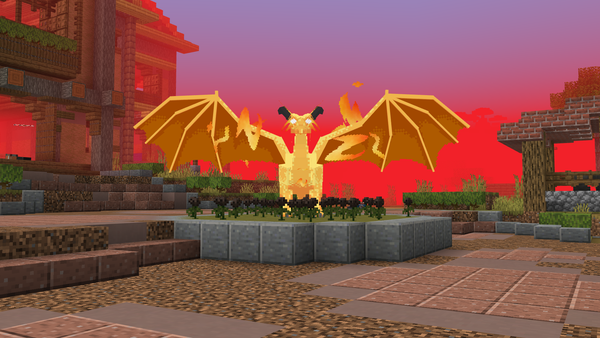A new video game puts climate solution tools in the hands of up to 80 million Minecraft players
Thank you for reading this post, don't forget to subscribe!By Daniel Cusick & E&E News

The heat dragon from Heat Wave Survival for Minecraft Education.
Minecraft
CLIMATEWIRE | The normally buttoned-down Atlantic Council is diving into the online gaming universe with hopes of raising climate disaster awareness among one of the world’s fastest-growing demographic groups: gamers.
A new interactive game called “Heat Wave Survival” was rolled out last week by the council’s Adrienne Arsht-Rockefeller Foundation Resilience Center. The organization is trying to tap into the 60 million people who use the popular online gaming platform Minecraft with a new version that pits gamers against an animated fire-breathing “heat dragon.”
Players “embark on a quest to protect their virtual village from the notorious heat dragon,” the center said in a statement. “They are challenged to explore countries around the world in search of cooling solutions that can not only protect them in the digital world but also in real life.”
On supporting science journalism
If you’re enjoying this article, consider supporting our award-winning journalism by subscribing. By purchasing a subscription you are helping to ensure the future of impactful stories about the discoveries and ideas shaping our world today.
The game is available now via the online learning platform Minecraft Education, owned by Microsoft Corp., and will be available to all Minecraft players in a few weeks, officials said. It is the latest in a suite of game-based entry points into the subject of climate change. Beyond being fun, creators say such games promote climate literacy by immersing players in simulated climate disasters where they must adapt or die.
“Games are actively consumed. They’re not passive,” Shayne Hayes, Arsht-Rock’s associate director of Video Game Initiatives, said in an interview. “They are a powerful medium for reinforcing the skills and knowledge that could help save lives.”
Helen Zbihlyj, Heat Wave Survival’s lead narrative writer at ReWrite Media, said the game took about nine months to develop and was tailored to meet classroom needs without losing its fun factor.
“Dragons are a fantastical way of showing global climate change in physical form,” Zbihlyj said. “In some of the original concept art, there’s a dragon made of flames coming into the window of an elderly woman watching a heat wave weather report on television. What better way to illustrate the intense heat that people are experiencing than with a fire-breathing dragon?”
Gamers will have access to two versions. One relies on an “adventure map” where players travel through a simulated landscape and encounter the heat dragon, then take actions to repel the beast. “The idea was make heat very tangible, something [players] can engage with to see the impact of extreme heat on their Minecraft villages,” Hayes said.
The other version, tailored for classroom use, offers a “build challenge” where players can gather tools and develop strategies “to build their own version of a heat-resilient urban area.” Solutions include cooling centers, parks, green space and reflective surfaces. Players will also be able travel in the game to four “real-world locations” — Brazil, Greece, India and Nigeria — “to see what those countries are really doing to address extreme heat,” Hayes added.
The Atlantic Council is not alone in its gaming efforts. At the 2019 United Nations Climate Action Summit in New York, officials launched the Playing for the Planet Alliance, a volunteer partnership between the U.N. Environment Programme and more than 30 game studios to set “ambitious, specific and time-based” commitments to meet sustainable development goals.
Reprinted from E&E News with permission from POLITICO, LLC. Copyright 2024. E&E News provides essential news for energy and environment professionals.

